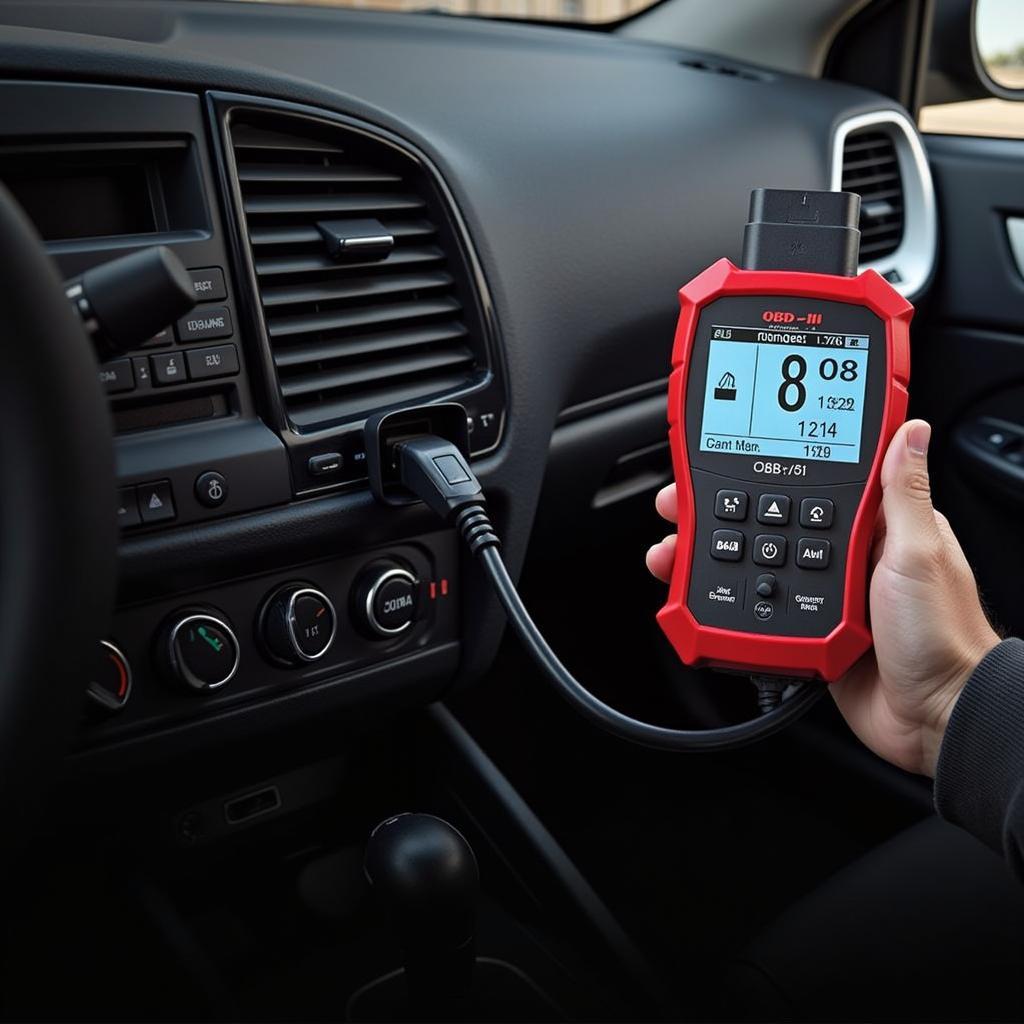Finding out what’s ailing your car can feel like deciphering ancient hieroglyphs. Luckily, you don’t need a Rosetta Stone, you need the right diagnostic tool. This article will explore the various tools available, from simple code readers to professional-grade diagnostic scanners, helping you understand what tool tells you what’s wrong with your car.
Decoding the Dashboard: Understanding Diagnostic Tools
There’s a wide range of diagnostic tools available, each with its own capabilities. Choosing the right one depends on your technical skills and the depth of information you need. Let’s break down the options:
Basic Code Readers: A First Glimpse Under the Hood
These handheld devices are the entry-level solution. They plug into your car’s OBD-II port (usually located under the dashboard) and read diagnostic trouble codes (DTCs). These codes are like your car’s way of saying, “Hey, something’s not right here!” Basic code readers will display the code, allowing you to look up its meaning online or in a repair manual. While useful for identifying simple issues, they typically don’t offer much beyond the code itself.
OBD-II Scan Tools: A Step Up in Diagnostics
OB-II scan tools offer more than just reading codes. They can also clear codes, display live data from various sensors, and perform some basic tests. This allows you to monitor things like engine temperature, fuel pressure, and oxygen sensor readings in real-time. These tools are ideal for DIY enthusiasts who want to delve a little deeper into their car’s systems.
 OBD-II Scan Tool Connected to Car
OBD-II Scan Tool Connected to Car
Professional-Grade Scanners: The Mechanic’s Arsenal
Professional-grade scan tools are the heavy hitters of the diagnostic world. They offer advanced features such as bidirectional control (allowing you to activate components like fuel injectors or solenoids), access to manufacturer-specific codes, and in-depth diagnostic procedures. These tools are expensive and complex, but essential for professional mechanics.
What Tool Tells You What’s Wrong With Your Car: Choosing the Right One
So, what tool tells you what’s wrong with your car? The answer depends on your needs. For basic code reading and clearing, a simple code reader will suffice. For more in-depth diagnostics and live data, an OBD-II scan tool is a good choice. And for professional-level diagnostics and repairs, a professional-grade scanner is a must-have.
 Mechanic Using Professional Scan Tool
Mechanic Using Professional Scan Tool
Beyond the Tools: Interpreting the Data
Having the right tool is only half the battle. Knowing how to interpret the data is crucial. DTCs are just starting points; they indicate a problem area, not the specific fault. Further investigation, using the tool’s capabilities or other diagnostic methods, is often necessary to pinpoint the exact issue.
Common Diagnostic Scenarios
Let’s consider some common situations:
-
Check Engine Light On: This is the most frequent reason people use diagnostic tools. The light can be triggered by a wide range of issues, from a loose gas cap to a faulty catalytic converter.
-
Poor Fuel Economy: A diagnostic tool can help identify problems with the fuel system, oxygen sensors, or other components that affect fuel efficiency.
-
Rough Idle or Misfires: These symptoms can indicate problems with spark plugs, ignition coils, or fuel injectors. A diagnostic tool can help pinpoint the faulty component.
“A proper diagnosis is the foundation of any successful repair,” says John Smith, ASE Certified Master Technician. “Using the right diagnostic tool is the first step in that process.”
Conclusion: Empowering You with Automotive Knowledge
Understanding what tool tells you what’s wrong with your car empowers you to take control of your vehicle’s maintenance. Whether you’re a DIYer or prefer to leave it to the professionals, knowing the capabilities of these tools can save you time, money, and frustration. Remember, the right diagnostic tool can be your key to unlocking the mysteries of your car’s health.
FAQ
-
What is an OBD-II port? The OBD-II port is a standardized connection point found in most vehicles manufactured after 1996. It allows access to the vehicle’s diagnostic system.
-
Can I clear codes with a basic code reader? Yes, most basic code readers allow you to clear diagnostic trouble codes.
-
Are professional-grade scan tools worth the investment for DIYers? For most DIYers, the cost and complexity of professional-grade scanners are not justified.
-
What does “bidirectional control” mean? Bidirectional control allows a diagnostic tool to not only read data but also send commands to activate components, aiding in testing and diagnostics.
-
Where can I find the meaning of DTCs? You can find DTC definitions online, in repair manuals, or within the software of some diagnostic tools.
-
What if my car was manufactured before 1996? Cars manufactured before 1996 may have different diagnostic systems and require specialized tools.
-
Can I use a diagnostic tool on any car make and model? Most modern OBD-II scan tools are compatible with a wide range of makes and models, but some may require specific adapters or software.
Need help with your car diagnostics? Contact us via WhatsApp: +1(641)206-8880, Email: [email protected] or visit us at 910 Cedar Lane, Chicago, IL 60605, USA. We have a 24/7 customer support team ready to assist you.

Leave a Reply